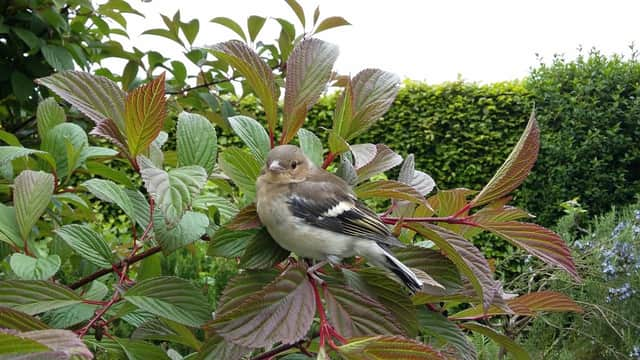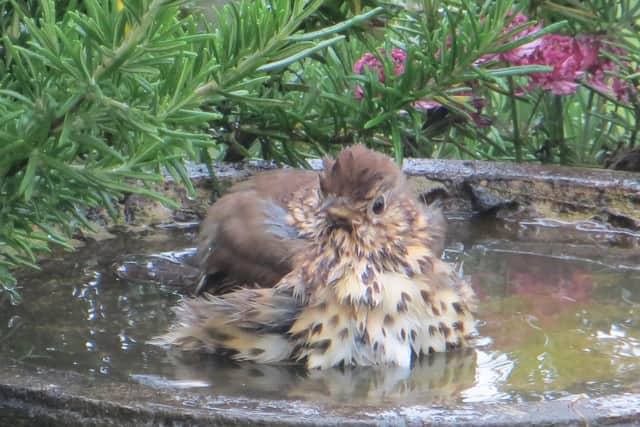The creature comforts of our garden


This has generally been successful and to our mutual advantage. We provide important habitats, food, protection for those taking up residence or just passing through, and in return they honour us with their presence and the most natural form of pest control.
However, their antics occasionally call for an element of tolerance, and it revolves around the plants we grow at various stages of their cultivation. We’ve all sown a drill of precious seeds and watched in horror as a host of sparrows drop in for a group dust bath. A pheasant who pops in daily for a handful of grain did just this on one of the raised vegetable beds last week.
Advertisement
Hide AdAdvertisement
Hide AdYear-round bird presence is such a wonderfully natural experience. The feeding station activity over winter, nesting in spring, competition, and behaviour in and between species, and constant foraging for food. It’s so exhilarating to have the company of a blackbird or robin when digging or planting, yet frustrating when the former decides to feast on your cultivated fruits as they ripen. Best way to avoid a love–hate relationship is by netting the produce securely or, agreeing to share everything.


Insect pests on the fruit, vegetable, and ornamental plants is something we learn to live with but there are lots of natural predators on our side. The presence of friendly lacewing, ladybird, violet ground beetle, centipede presence, helps maintain a balance. And just for the record, wasps aren’t all about stinging, although they can be a nuisance when drowsy, roused or their nest’s near a pathway. They consume a mass of aphids and leaf-eating caterpillars in season.
Pollinating insects are an essential part of gardening too so, we ensure they have a year-round supply of relevant plants in flower. Even the patch of so-called weeds, including nettles, which is found on spare land in a corner, has a purpose. It sustains the developing larvae of our favourite butterflies, including the red admiral.
There’s no shortage of predators. A fox once passed through the garden at dusk and buried a large object in the border. On later inspection, I found it to be half a loaf of bread. A barn owl currently pauses on the field gate and a sparrowhawk hedgehops between gardens in daytime.
Is a roe deer a visitor too far?
Advertisement
Hide AdAdvertisement
Hide AdMy list of starting essentials to attract the greatest diversity of wildlife embraces hedges, shrubs, fruits, flowers, nesting sites, feeding stations, ponds and a natural area. There is so much information relating to this subject in gardening magazines and online.
Nesting boxes differ in construction depending on the species targeted, be it friendly insects, hedgehogs or birds. They’ve always been available for purchase but there’s such a sense of achievement when the first animal takes up residence in one you’ve constructed yourself.
The pre-formed water feature is small and natural but supports many species. The newts, frogs and toads that emerge from it treat the garden as their hunting ground for slow-moving pests.
I’ve just been reminded that there’s a fine line between the excitement of seeing a different animal in your garden as a one-off visitor and welcoming it with open arms as a resident.
Advertisement
Hide AdAdvertisement
Hide AdEarly one morning last week, as I stood at the kitchen window, a large body movement on a path between the beech hedge and row of apples caught the eye. A roe deer. Wow! For months they’ve been passing by and pausing to look through the field gate.
Mobile in hand, I stood perfectly still as it nibbled flower clusters and leaves on the Braeburn apple, then wandered over to those on the Conference pear. Thankfully, it bypassed the asparagus spears destined for the evening meal. It tried a strawberry plant, inspected the vegetable beds, and departed gracefully over the lawn.
Undeniably an attractive creature but deer have a reputation for causing fatal damage to expensive trees and shrubs, especially the life-giving bark. They’ll eat any young shoots especially those of roses. We do tolerate the occasional rabbit but a resident deer? Perhaps it’s a step too far!